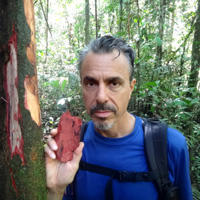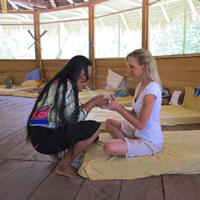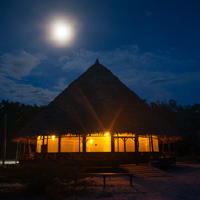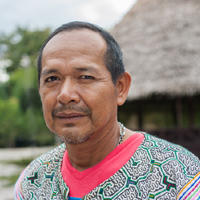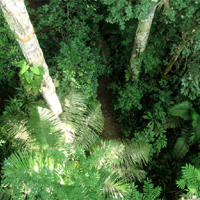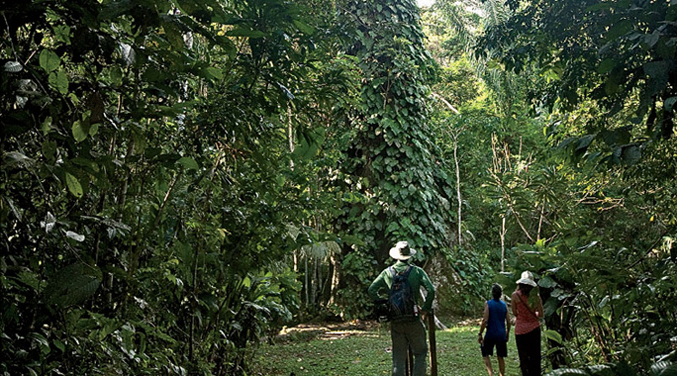
Steve Hendricks, Chris Kilham, Zoe Helene look at Giant Amazonian Ceiba Tree. Photo by Ivan Kashinsky
No jungle or river is too remote for self-described medicine hunter Chris Kilham, who travels the globe looking for plants to boost our vitality, ease our pain, and turn us on.
In the Peruvian Amazon, in the city of Iquitos, there is a soiled waterfront barrio called Belén, within whose borders strains a vast market. Among its cacophonous lanes is a passageway, freckled with fish guts, fly-covered watermelon rinds, and mysterious oozes, known as Witches Alley. When the sun is savage, which is to say when it is up, the keepers of its stalls string tarps overhead in a patchwork defense. Against the humidity they have no counterattack, although someday a go-getter here will probably find a way to bottle humidity and make a killing in the export trade. These vendors tout powders and potions no less wondrous.
Medicinal Plant hunter Chris Kilham, explorer in residence at the University of Massachusetts Amherst, was strolling Witches Alley, explaining its wares. Kilham is just over 60, with the (relatively) unlined skin and (decidedly) trim form of a man in his upper forties. He has been variously employed as a yoga teacher, honorary consul to the U.S. for the Republic of Vanuatu, child star of a Welch's grape juice commercial, and author of a New Age book that offers second-life insurance to those who fear an undesirable reincarnation. For the past two decades, he has made his living as a medicinal-plant hunter, one of a small cohort of scouts who ferret around obscure parts of the world to bring wellness, vitality, and, just perhaps, sexual potency to Western consumers. His chief employer is Naturex, a French company that is one of the largest processors of plant extracts in the world and has bestowed on him the somewhat orotund title of sustainability ambassador.
Navigating Witches Alley with Kilham was an unhurried affair, since every stall offered a didactic opportunity. He spoke in the measured cadences of someone who knew he was saying slightly unbelievable things that would be more believable the more level his delivery. Plying his trade on television has abetted the habit. Kilham discovered years ago that TV networks, like universities, enjoyed having a botanical Indiana Jones around, so he christened himself the Medicine Hunter, complete with logo, and now appears regularly on-air as the Fox News Medicine Hunter. He collects honorifics the way some people collect fridge magnets.
Kilham stopped at a stall with caiman skulls the size of desktop computers and picked up a bottle of viscous crimson liquid.
"Sangre de Drago," he said admiringly. "Dragon's Blood. Latin binomial Croton lechleri. It's been used for ages for just about anything bad that can happen to skin—bites, burns, sores, rashes, you name it."
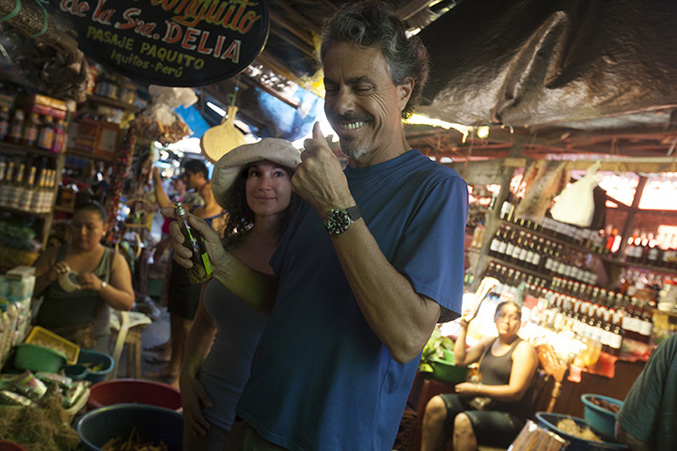
Medicine Hunter Chris Kilham and Zoe Helene explore Witches Alley, Iquitos, Peru. Photo by Ivan Kashinsky.
“A lot of people think medicine hunting is all Chris trekking through the jungle. Or, for that matter, the chiefs and (male) elders he works with. The men get the headlines, but it’s the women behind the scenes who are doing the planting and harvesting and chopping.” – Zoe Helene, Outside Magazine, January 2014
We paused at stalls offering cat's claw, a woody vine that studies show is an antioxidant and possibly an anticarcinogen; sap from the catahua tree, used as both a poison for darts and a purgative for the stomach; and a pile of bright red achiote seeds advertised as aids to the prostate.
A few paces farther along, Kilham came to a full stop. Before us were a couple of tables with a prodigious quantity of strange brews. The stall next door was also well bottled, and so too the next and the next and the next.
"We have arrived," he said, spreading his arms wide. "Welcome to Aphrodisia."
The forest of bottles bore the tattered and stained labels of Inca Kola, Fanta, Trapiche Malbec, and other assaults to the palate. Kilham zeroed in on one whose second label—each bottle bore a new one, plastered over the remains of the old one—announced its contents, cryptically, as "LPM" and its brewer as El Chamán de la Selva, the Jungle Shaman.
LPM contained what Kilham had come to Peru for: chuchuhuasi. Pronounced chew-chew-wah-see, it is a towering canopy tree so little known in the West that, until last year, it had no entry in that great registry of human fact, Wikipedia. The Shipibo people, native to the region, regard the tree's bark as a general tonic, an anti-inflammatory, and an analgesic for the relief of rheumatism, arthritis, menstrual cramps, and back pain. "Studies show that it's also an immune-system modulator," Kilham said.
I was glad for this knowledge, but my interest in chuchuhuasi was more prurient, for the bark, above all, is prized locally as an aphrodisiac.
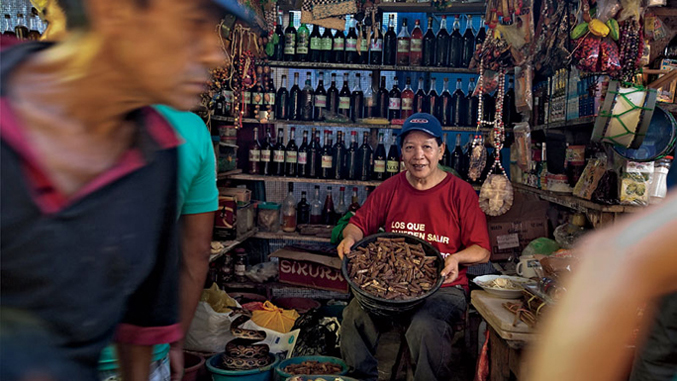
A vendor of chuchuhuasi bark in Witches Alley. Photo by Ivan Kashinsky
The round, vaguely lascivious stall keeper gave Kilham a free pour of LPM in a plastic cup. The Medicine Hunter ventured a swig and passed the rest around among our little party. The concoction tasted liqueur-ish—sweet, but not cloyingly so. LPM, the round man said, stood for Levántate Pájaro Muerto—Arise Dead Bird. None of the male drinkers in our group, however, reported such a rise. Kilham's wife and business partner, Zoe Helene, the sole woman among us, felt no stimulus either.
"It's not meant to take effect immediately," Kilham offered. "With most of these preparations, you're supposed to take them for weeks to see results." It sounded like a good business model—the Prozac plan.
Among the chuchuhuasi potions competing for shelf space were ¡Para! ¡Para! (Stand Up! Stand Up!), Levántate Lázaro (Arise Lazarus), Tumba Hembra (Female Tomb, more liberally translated as Knock Her Flat), and "SSVS," short for Siete Veces Sin Sacarla (Seven Times Without Pulling Out). It is the custom the world over to market sex enhancers to men, but many of these brews were said to have a good effect on women, too. I asked Kilham how many, in his estimation, actually worked.
"Some of these shamans," he said, choosing his words with care, "do a better job with ingredients and processing than others. And so some will be more effective." He looked thoughtful, then added, "You know, there's a place for reductive scientific thinking. There's a need for lab work and peer-reviewed research. But with this"—he gestured at the potions before us—"I'm open to the idea that any of this stuff might work."
Wellness through plants does a booming business in the United States. About one in five American adults takes a supplement with at least one herb in it. The yearly sales of all those pills, powders, and tinctures—most of them unregulated by the Food and Drug Administration—total roughly $30 billion in the United States and $100 billion worldwide. Someone has to find all those plants, and Kilham is one of the foremost someones.
He has been stalking herbs for a quarter-century. An indigenous Bostonian with a bachelor's degree from UMass Amherst in mind-body disciplines, a curriculum of his own designing, Kilham spent the 1980s running the nutrition departments of the natural-foods chain Bread and Circus, eventually rising to vice president for marketing. Along the way, he wrote books like The Complete Shopper's Guide to Natural Foods and, what remains his most popular work, The Five Tibetans: Five Dynamic Exercises for Health, Energy, and Personal Power, which has been translated into 26 languages since its publication in 1994.
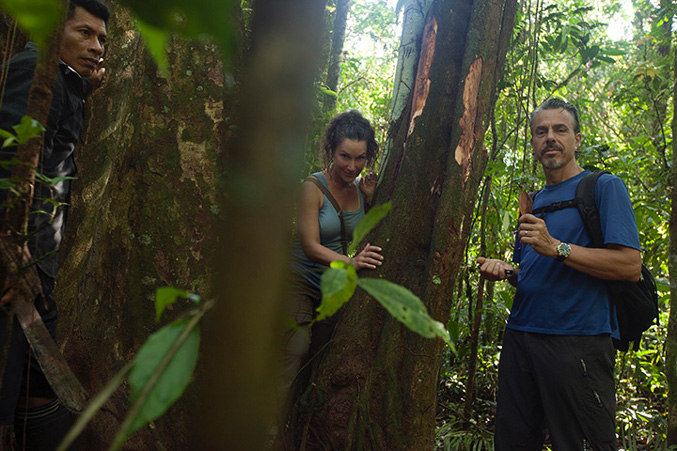
From left to right, Native Amazonian guide, Zoe Helene, Chris Kilham. Deep in the Peruvian Amazon. Photo by Ivan Kashinsky
Kilham's first big sortie into medicine hunting came the next year, when he went to the South Pacific to investigate a root called kava. Long used by Melanesians as a sedative, kava had been sold in the West, but meagerly, before Kilham convinced Pure World Botanicals to send him to Vanuatu to look for a good supply. Pure World, which was bought by Naturex in 2005, was a refiner of raw ingredients for makers of herbal products. If you used ginkgo biloba or St. John's wort or ginseng at the time, odds were fair that it had passed through Pure World's New Jersey plant. Kilham secured a supply of the root and spent the next few years talking up kava in lectures, interviews, and a book, Kava: Medicine Hunting in Paradise.
"To become a star, every herb needs a prophet," a Wall Street Journal reporter wrote in 1998. "In the case of kava, it is Mr. Kilham.… He has become a one-man public relations agency for the herb."
Demand for kava soared. By the late nineties, Kilham estimates, worldwide sales were in the ballpark of $200 million. Vanuatu's gross national product grew by about 8 percent. The tribespeople of one island made Kilham an honorary chief, and he served as one of Vanuatu's consuls to the United States from 1997 to 2000.
Kilham went on to popularize more herbal remedies, with a particular passion for what he calls "hot plants"—aphrodisiacs. In Malaysia, he found tongkat ali, a slender tree whose name means "Ali's walking stick" and whose root has been shown to increase testosterone. In central Africa, he encountered yohimbe, an evergreen whose bark stimulates nerves in the lower spine, with animating consequences for the loins. In China, he studied epimedium (horny goat weed), which yields firmer and longer-lasting erections, and in Lebanon, he came across zallouh, a shrub that, legend has it, enabled King Solomon to give pleasure nightly to a substantial fraction of his 700 wives and 300 concubines. Many of these herbs tested favorably in independent modern studies: in one Lebanese trial of zallouh, for example, 80 percent of men with erectile dysfunction reported improvement.
Kilham, who is dutiful in his investigations, has self-experimented with these and a great many other herbs. In his 2004 book Hot Plants: Nature's Proven Sex Boosters for Men and Women, he describes a Ghanaian feast at which two hostesses offered him a yohimbe-based drink, after which the trio repaired to a more secluded spot. ("The night wore on, happily and delightfully," he synopsized.)
Various of Kilham's wives have also aided in his research. Forty-nine-year-old Helene, who styles herself the Cosmic Sister, is his sixth wife; theirs is both his longest marriage (six years), and his last, the couple insists. A former marketer raised in North Carolina and New Zealand, Helene runs their sprawling website, MedicineHunter.com, helps with Kilham's travel logistics, and sometimes accompanies him on the medicine trail. On her own time, she (writes) blogs about environmental devastation, most notably the plight of New Zealand's endangered Maui's dolphin, of which a mere 55 survive.
"A lot of people think medicine hunting is all Chris trekking through the jungle," she told me. "Or, for that matter, the chiefs and elders he works with. The men get the headlines. But it's women behind the scenes who are doing the planting and harvesting and chopping."
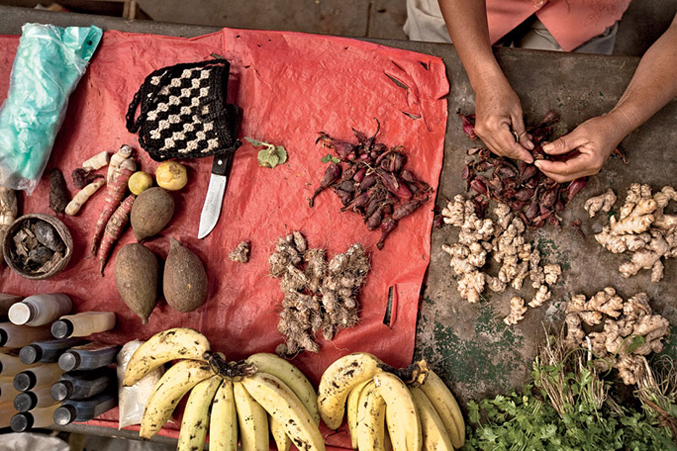
A woman sells natural medicines and food in a market in Cotamana. Photo by Ivan Kashinsky
Helene was a planter, harvester, and chopper. Kilham did not disagree in the least. As for his own job description, he was frank that he's no scientist, just a self-taught guy who doesn't so much evaluate plants (though he thinks he does OK with that) as evaluate what people think of them. As he sees it, if a tribe or nation has used a plant for ten or twenty or a hundred generations because they think it does X, then more often than not it probably does something like X. Why else would they use it?
"It's not rocket science," he said. "But it's patient, necessary work, and it helps the local people, who make a little better living because of it, and it helps people in the West, who are getting this health-giving plant. It helps Naturex make money, too, which some people reflexively don't like, but they have to make money if they're going to work with these plants, right? And since we give people what they need to harvest the stuff sustainably, it's good for the environment, too. I see what we do as win-win-win-win."
Kilham's work has earned the approval of wellness-popularizing doctors like Andrew Weil, who hails him as "a trustworthy guide," and Mehmet Oz, who has given him repeated segments on The Dr. Oz Show. James A. Duke, a retired USDA botanist who authored The Green Pharmacy, the herbal-supplement standard, says, "He's quite knowledgeable. Of the products that he's worked on, the ones that I know of at least, I approve. They're real, and he's right to advocate for them."
Not everyone sees it thus, including some mainstream medicine men who would prefer Kilham not peddle plants until they have been proven safe and effective by double-blind human trials—trials that are, of course, rather expensive. One such critic, Steven Novella, a neurologist at the Yale School of Medicine and founding editor of ScienceBasedMedicine.com, cites Kilham as an example of what happens when "ideology trumps logic and science." Novella writes on his website, "I think he is too soft on botanicals and too harsh on the pharmaceutical industry."
OF ALL THE HOT hot plants that Kilham has promoted, perhaps the hottest is a South American tuber called maca. Kilham began hearing enticing things about it in the mid-1990s and eventually told Pure World that if even half of what he was hearing was true, maca could make the other plants in Pure World's garden look like so many dandelions.
Maca resembles a turnip that got confused and sprouted mustard leaves. It grows high in the Peruvian Andes, rarely below 8,000 feet, sometimes above 15,000. The Incas seem to have thought it a gift from the gods: it was said to inflate stamina, vitality, and virility. According to legend, the Incas gave maca to warriors before battle, but after a conquest they took it away to protect vanquished women from maca-fueled lust. Another story holds that the Spaniards, after conquering the Incas, gave it to their livestock, which had become barren in the high altitude, and the animals became fertile again. But it was not until the end of the last century, with the swell of interest in alternative medicine, that maca spread beyond the highlands.
Kilham went to Peru for Pure World in 1998 and came back convinced. "Maca is a food for epic sex," he summarized. "Among the hot plants, maca is as hot as they get."
Pure World commissioned a team of Chinese researchers to see whether rodents agreed with him. Maca-dosed rats had sex far more often than their non-dosed confreres, and in one study even castrated rats that were fed maca got erections as quickly, when electrically stimulated, as some intact, similarly stimulated testosterone-fed rats. A modest amount of maca, in short, could rival testicles and testosterone.

Kids play soccer in the slums of Iquitos, Peru. Photo by Ivan Kashinsky
Preliminary human trials were promising as well: In studies at Australia's Victoria University and Massachusetts General Hospital, women who had lost libido after menopause or while taking antidepressants reported a stronger sex drive on maca. In a Peruvian trial, healthy men who took maca reported heightened sexual desire. In Italy, men with erectile dysfunction reported improved turgidity. And in the UK, in a test of maca's effect on general stamina, eight cyclists rode 40 kilometers, then took maca for two weeks and rode the distance again. They averaged a minute faster.
Pure World contracted with Peruvian farmers to grow, harvest, and dry the maca, then the company refined it into powders called Maca Pure and Maca Tonic. These it sold to herbal-supplement manufacturers like Nature's Bounty and EuroPharma to put into pills or bottles for retail sale.
To the press, meanwhile, Kilham hailed maca as "Peru's natural Viagra" and a begetter of "Chinese New Year's fireworks in your pants." (This was not exactly how the Andean highlanders I spoke to put it. They lauded maca, but not as feverishly. On the other hand, James Duke, the USDA botanist, told me, "When I first heard of maca, I thought it was bullshit. But I tried it and felt some stirrings. Me—in my eighties! It's real.")
Maca proliferated on the shelves of GNC and Whole Foods stores, and websites dedicated to it sprang up. American TV crews flew to Lima, and traders from Europe and Japan got into the game. Worldwide sales have now reached something like a quarter-billion dollars. Today, Naturex is one of the world's leading processors of maca, which is among its ten bestselling botanicals. Still, it is far outsold by nonsexual extracts like cranberry (marketed for its antibacterial properties), ginseng (for mental acuity), and bilberry (for vision). Indeed, sex enhancers as a whole make up a mere 15 percent of Naturex's U.S. sales, leading one to conclude that, contrary to the old adage, sex doesn't sell. Kilham says not so.
"The demand for sex enhancers is vast," he explains. "But so is the number of products. Guy walks into the supplements aisle, he doesn't know what works and what doesn't. Even with a product like maca, which he may know is legitimate, a lot of companies can't guarantee that each dose they've processed will have a standardized amount of the active compounds. So maybe he buys a product that's not so good and it doesn't do anything for him, and he tells everyone, 'This maca stuff is a waste of money.'"
To relieve problems of trust, Kilham teamed up with the manufacturer Purity Products to buy Naturex's maca, turn it into capsules, and market it as Chris Kilham's Vital Maca, with his respected face on the label. Purity also makes Chris Kilham's Vital Brilliance, Chris Kilham's Vital Focus, and Chris Kilham's Vital Rest. At $2,086.20 per year, attaining full Kilham-ian vitality is not for the faint of budgetary heart. His own ledger is enhanced by royalties from these and other products by about $125,000 a year—not opulence, but neither will he starve.
NATUREX WOULD NOT object if chuchuhuasi became the next maca. But with no scientific research yet on the bark's sex benefits, Naturex and Kilham are emphasizing its analgesic and anti-inflammatory properties, for which there is a small body of supporting science. Kilham thinks the bark may someday be a common salve for the aches of arthritis sufferers and through-hikers. His self-experimentation suggests that chuchuhuasi is on par with ibuprofen for anti-inflammation—and perhaps with maca for sex.
All of which was good enough to merit a trip deep into Amazonia. A few days before we visited Witches Alley, Kilham led our party up the remote Ucayali to meet a Shipibo trader who, if all went well, would supply chuchuhuasi to the world. It is 270 scrubby, heavily logged miles upriver from the timber port of Pucallpa to Contamaná, where the trader, Margarita Maldonado, lives.
Our vessel was the Apus, a small two-decker owned by Kilham's trading partner, Sergio Cam. ("Absolutely every-thing I do down here, I do because Sergio makes it happen," Kilham said.) Cam, Kilham's junior by six years, is a man of ample cheer and circumferences: waist, chest, and head. If his face lacked its breadth, the smile that habitually plays across it would have to hang in the air.
Our trip was the maiden voyage of the Apus, collectively anyway: her decking, to judge from its wear, might have been scavenged from the Niña, and her motor could have been known to the Merrimack. Cam had cobbled her together to bring Naturex's raw goods out of the jungle and, on the empty trips in, to bring a free, floating dental clinic to the villages where Naturex traded. Naturex, via Cam, had set up a similar clinic in the region that supplied its maca.
"Do we do this just because we're nice guys?" Cam said. "No, man. We do it because it's smart business. If the people know we'll help them, they're gonna like us, and they're gonna be good back to us and give us a reliable supply."
It didn't seem the worst form of self-interest. The Apus shoved off with 14 crew and passengers, including Kilham, Helene, Cam, and a medicine man who dressed like Tiger Woods and gave cranial rubs with his thumbs that felt like having five-irons bored into your skull. There were also three gentlemen with sidearms and bullet loops strapped to their thighs.
"For pirates," Kilham explained. "The qualification you look for in guards down here is ammo. You want a lot."
"The pirates here don't really hurt people," Cam reassured us. "They usually just slap you around and tie you to the boat and take your stuff. They don't sink it or kill you—just leave you to drift. Someone will find you."
As it happened, we had more pressing concerns. The Apus sailed her first and last uneventful hour before getting stuck on a mud bar. The crew pulled out long wooden two-by-two's and after 15 spirited minutes heaved us free. A half-hour of calm sailing ensued, then the engine made a sudden racket like a lawn mower running over a pile of branches and died. We learned then that the Apus had no anchor, which seemed an odd choice to a landlubber, so we drifted aimlessly until the boat lodged itself on a submerged hummock. Here, a broken water pump was diagnosed, and the pump from a small secondary engine was cannibalized, with the hope of limping the remaining miles to Contamaná. It was not clear how many, because the boat had no GPS. We could not radio for help because there was no radio, another arresting feature of the Apus.
When the pump was at last installed, a noise resembling a motor rang out triumphantly. But only after four or five men, including Kilham, jumped overboard and shoved on the hull in chest-high water for an hour and a half were we set free.
Kilham alone looked more refreshed than worn on returning to the boat. He was an advertisement for herbal living. "Rule number one of medicine hunting," he said, toweling off, "you will have transportation problems. You just don't know what or when."
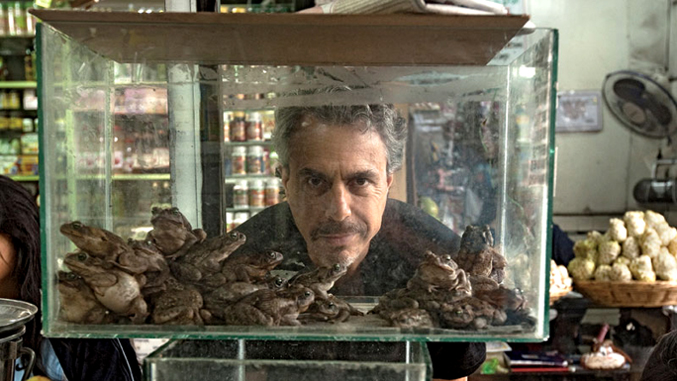
Frogs that will be blended with Maca in Peruvian Mojo Smoothie. Photo by Ivan Kashinsky
IN THE END, we made the remaining five hours to Contamaná in a mere thirty. It was an attractive little town, with crumbling buildings and a couple of leafy plazas. Maldonado's compound consisted of a warehouse, drying shed, house, and fence, all of which could have fit on a basketball court with room to take a few jump shots. Every so often, men would pull up on the riverbank in skiffs and haul huge bundles of roots or bark over to the open-air shed, where their contents would be spread to dry on pallets before being shipped up or down the river for sale.
Maldonado was a short, polite woman who parted with her words on an as-needed basis. After Kilham's four-day journey from Amherst to Hartford to Newark to Lima to Pucallpa to Contamaná, I had expected some serious bargaining—maybe an appraisal of the crop or a gentle but probing interrogation of the harvesters or haulers along the chain of supply. A few years earlier, Kilham had entered negotiations with a Shipibo chief to supply Naturex with botanicals, only to discover that the chief was a con man with nothing to deliver. Even with an honest broker, he'd told me, it was often hard to know whether the person could deliver goods in the right quantity, of the right quality, at the right time.
But today Kilham merely told Maldonado that Naturex's interest in chuchuhuasi was becoming acute and the company would probably order a batch in a few months. Could she deliver? She said she could. And that was that. The discussion took about as long as it takes to get a tamperproof seal off a vitamin bottle. It seemed awfully little to come so far for, and I asked Kilham later whether he couldn't have just picked up the phone.
"I know it doesn't seem like much that we're doing here," he replied, "but no, you can't just make phone calls. If you don't come in person, the people don't know you're serious, they don't trust you, maybe they sell their stuff to someone else. And you don't learn whether you can count on them."
This was no doubt true, but it didn't quite sound like the whole truth. I recalled an exchange Kilham had had some years ago with a reporter who asked, "What does maca need for people to start using it?"
"It needs you," he had answered.
The Medicine Hunter had gotten his you on this trip. I had thought I was coming to the Amazon to watch him do fieldwork, but it gradually dawned on me that the bulk of the work was working me. It is a virtue of Kilham, however, that he is candid when questioned, and when I asked him about it later, he acknowledged unhesitatingly that medicine hunting and publicity hunting were of a piece.
"At least half of my work involves getting messages out to the world," he said. "If I can show you what is going on—the deforestation, the loss of habitat, the absolutely hor-rific marginalization of native people, the benefit of these plants—then maybe, just maybe, you will write about it. And just maybe that will make a difference."
"Plus," he said, "every once in a while you make a serendipitous find. You never know when you're going to make it, but you will make it if you keep coming back."
Indeed, he made just such a find in Contamaná—an oil called copaiba that he'd been seeking for months. Copaiba is soothing to the skin, but it usually comes out of the tree as a dark gum, which is about as appealing as tar to cosmetics companies. However, from the depths of her compound, Maldonado produced a bottle of copaiba in milky amber.
Kilham held it like a kid with a report card that said all A's. "This could be a big thing," he said. "A big, big thing."
IN THE MONTHS after our trip, I received periodic e-mail updates from Kilham. He'd visited Morocco's Atlas Mountains for the olive-leaf harvest ("olive leaves are anti-viral, anti-fungal, antibacterial"), the Ivory Coast ("tons of army guys with machine guns stopping us constantly, great food, wonderful people"), Namibia, South Africa, Hong Kong, and the Peruvian Amazon again. He would soon be off to Siberia, he wrote, to check out a powerful anabolic plant called maral root. ("There are wild horses that eat the stuff regularly, and they look like the Incredible Hulk. You've never seen horses like these. They make Clydesdales look like anorexic runway models.… I expect very big things from this, to take the market by storm.")
It was about what you'd expect of a man who has logged three million miles by air alone. I liked thinking about Kilham among Clydesdale-dwarfing steeds, or having guns trained on him at military checkpoints, or shoving a boat out of the Ucayali mud, whenever I took an echinacea pill or drank ginseng tea or, truth be told, popped a maca capsule.
One day not long ago, I received a small package containing a bottle of chuchuhuasi tincture from Kilham with the note: "It's happening." Over the next few weeks I partook of it with some liberality, but I could not pass judgment on its effects. My sexual appetite seemed normal, but then again, it waxes and wanes, like everyone else's.
Chuchuhuasi still stands today where maca did a quarter-century ago—tradition's drug, not the lab's. Perhaps 25 years from now it will achieve a maca-like respectability, backed by a young but growing science. Or perhaps it will have joined Spanish fly and rhinoceros horn in the dustbin of erotic history. The Medicine Hunter has proposed; science, if inclined, can dispose.
Steve Hendricks is the author, most recently, of A Kidnapping in Milan: The CIA on Trial.
